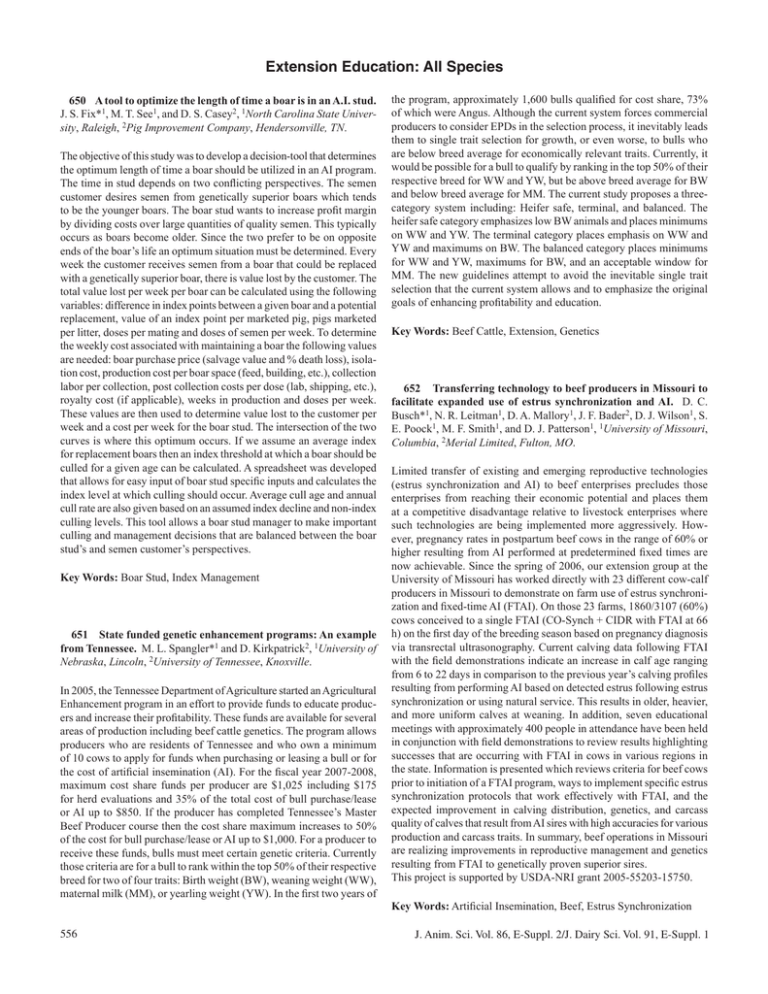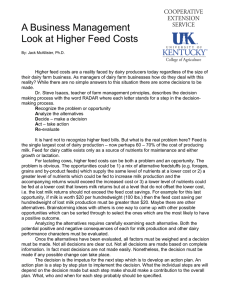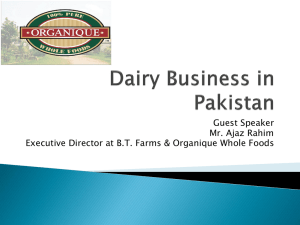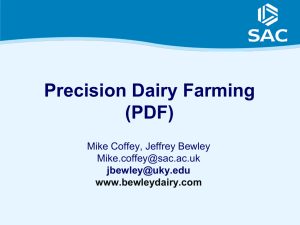the program, approximately 1,600 bulls qualified for cost share, 73% 650
advertisement

Extension Education: All Species 650 A tool to optimize the length of time a boar is in an A.I. stud. J. S. Fix*1, M. T. See1, and D. S. Casey2, 1North Carolina State University, Raleigh, 2Pig Improvement Company, Hendersonville, TN. The objective of this study was to develop a decision-tool that determines the optimum length of time a boar should be utilized in an AI program. The time in stud depends on two conflicting perspectives. The semen customer desires semen from genetically superior boars which tends to be the younger boars. The boar stud wants to increase profit margin by dividing costs over large quantities of quality semen. This typically occurs as boars become older. Since the two prefer to be on opposite ends of the boar’s life an optimum situation must be determined. Every week the customer receives semen from a boar that could be replaced with a genetically superior boar, there is value lost by the customer. The total value lost per week per boar can be calculated using the following variables: difference in index points between a given boar and a potential replacement, value of an index point per marketed pig, pigs marketed per litter, doses per mating and doses of semen per week. To determine the weekly cost associated with maintaining a boar the following values are needed: boar purchase price (salvage value and % death loss), isolation cost, production cost per boar space (feed, building, etc.), collection labor per collection, post collection costs per dose (lab, shipping, etc.), royalty cost (if applicable), weeks in production and doses per week. These values are then used to determine value lost to the customer per week and a cost per week for the boar stud. The intersection of the two curves is where this optimum occurs. If we assume an average index for replacement boars then an index threshold at which a boar should be culled for a given age can be calculated. A spreadsheet was developed that allows for easy input of boar stud specific inputs and calculates the index level at which culling should occur. Average cull age and annual cull rate are also given based on an assumed index decline and non-index culling levels. This tool allows a boar stud manager to make important culling and management decisions that are balanced between the boar stud’s and semen customer’s perspectives. Key Words: Boar Stud, Index Management 651 State funded genetic enhancement programs: An example from Tennessee. M. L. Spangler*1 and D. Kirkpatrick2, 1University of Nebraska, Lincoln, 2University of Tennessee, Knoxville. In 2005, the Tennessee Department of Agriculture started an Agricultural Enhancement program in an effort to provide funds to educate producers and increase their profitability. These funds are available for several areas of production including beef cattle genetics. The program allows producers who are residents of Tennessee and who own a minimum of 10 cows to apply for funds when purchasing or leasing a bull or for the cost of artificial insemination (AI). For the fiscal year 2007-2008, maximum cost share funds per producer are $1,025 including $175 for herd evaluations and 35% of the total cost of bull purchase/lease or AI up to $850. If the producer has completed Tennessee’s Master Beef Producer course then the cost share maximum increases to 50% of the cost for bull purchase/lease or AI up to $1,000. For a producer to receive these funds, bulls must meet certain genetic criteria. Currently those criteria are for a bull to rank within the top 50% of their respective breed for two of four traits: Birth weight (BW), weaning weight (WW), maternal milk (MM), or yearling weight (YW). In the first two years of 556 the program, approximately 1,600 bulls qualified for cost share, 73% of which were Angus. Although the current system forces commercial producers to consider EPDs in the selection process, it inevitably leads them to single trait selection for growth, or even worse, to bulls who are below breed average for economically relevant traits. Currently, it would be possible for a bull to qualify by ranking in the top 50% of their respective breed for WW and YW, but be above breed average for BW and below breed average for MM. The current study proposes a threecategory system including: Heifer safe, terminal, and balanced. The heifer safe category emphasizes low BW animals and places minimums on WW and YW. The terminal category places emphasis on WW and YW and maximums on BW. The balanced category places minimums for WW and YW, maximums for BW, and an acceptable window for MM. The new guidelines attempt to avoid the inevitable single trait selection that the current system allows and to emphasize the original goals of enhancing profitability and education. Key Words: Beef Cattle, Extension, Genetics 652 Transferring technology to beef producers in Missouri to facilitate expanded use of estrus synchronization and AI. D. C. Busch*1, N. R. Leitman1, D. A. Mallory1, J. F. Bader2, D. J. Wilson1, S. E. Poock1, M. F. Smith1, and D. J. Patterson1, 1University of Missouri, Columbia, 2Merial Limited, Fulton, MO. Limited transfer of existing and emerging reproductive technologies (estrus synchronization and AI) to beef enterprises precludes those enterprises from reaching their economic potential and places them at a competitive disadvantage relative to livestock enterprises where such technologies are being implemented more aggressively. However, pregnancy rates in postpartum beef cows in the range of 60% or higher resulting from AI performed at predetermined fixed times are now achievable. Since the spring of 2006, our extension group at the University of Missouri has worked directly with 23 different cow-calf producers in Missouri to demonstrate on farm use of estrus synchronization and fixed-time AI (FTAI). On those 23 farms, 1860/3107 (60%) cows conceived to a single FTAI (CO-Synch + CIDR with FTAI at 66 h) on the first day of the breeding season based on pregnancy diagnosis via transrectal ultrasonography. Current calving data following FTAI with the field demonstrations indicate an increase in calf age ranging from 6 to 22 days in comparison to the previous year’s calving profiles resulting from performing AI based on detected estrus following estrus synchronization or using natural service. This results in older, heavier, and more uniform calves at weaning. In addition, seven educational meetings with approximately 400 people in attendance have been held in conjunction with field demonstrations to review results highlighting successes that are occurring with FTAI in cows in various regions in the state. Information is presented which reviews criteria for beef cows prior to initiation of a FTAI program, ways to implement specific estrus synchronization protocols that work effectively with FTAI, and the expected improvement in calving distribution, genetics, and carcass quality of calves that result from AI sires with high accuracies for various production and carcass traits. In summary, beef operations in Missouri are realizing improvements in reproductive management and genetics resulting from FTAI to genetically proven superior sires. This project is supported by USDA-NRI grant 2005-55203-15750. Key Words: Artificial Insemination, Beef, Estrus Synchronization J. Anim. Sci. Vol. 86, E-Suppl. 2/J. Dairy Sci. Vol. 91, E-Suppl. 1 653 Evaluation of on-farm pasteurization systems. J. A. ElizondoSalazar*1,2, C. F. Vargas-Rodríguez2, S. C. Donaldson1, B. M. Jayarao1, and A. J. Heinrichs1, 1The Pennsylvania State University, University Park, 2Estación Experimental Alfredo Volio Mata, Costa Rica. Waste milk has been fed to calves for many years but concerns with bacteria contamination as well as possible transmission of diseases through feeding waste milk have discouraged many producers from feeding calves with this milk. Pasteurization of waste milk is one option to reduce management risk while utilizing a valuable, low cost liquid feed source for calves. However, many farms lack a protocol to adequately monitor the efficiency of their pasteurizing system. A study was carry out to evaluate on-farm pasteurization systems using 6 farms with different pasteurization systems, including both HTST and batch pasteurizers. Milk samples were taken pre- and post pasteurization and immediately frozen to -20°C for later bacterial culture. Samples were taken for a period of approximately 15 d, twice daily. All milk samples were examined for standard plate count (SPC), coagulase-negative staphylococci (CNS) count, environmental streptococci (ES) count, coliform (CC) count, gram-negative noncoliform (NC) count, Streptococcus agalactiae (SAG) count, and Staphylococcus aureus (SA) count. The SPC from all farms in the pre-pasteurized samples ranged from 7,415 to 250,822 CFU/mL while in the post-pasteurized samples ranged from 461 to 30,625 CFU/mL. Pasteurization reduced the SPC to < 10% of the original count in 81% (range 53 to 100%) of the samples. CNS count was reduced to < 10% of the original count in 86% (range 52 to 100%), meanwhile CC was reduced in 83% (range 52 to 97%) of the samples, meaning that pasteurization systems effectively reduced the bacteria counts of waste milk. However, 2 farms did not reduce the bacterial population in approximately 50% of the samples, suggesting that incomplete pasteurization may be a common problem and monitoring pasteurizer performance is an important step in assuring the quality of waste milk after pasteurization. Key Words: Pasteurization, Waste Milk, Bacteria 654 Managing the newly created livestock gross margin for dairy (LGM-Dairy) insurance under seasonal climate variability. V. E. Cabrera*1 and D. Solis2, 1New Mexico State University, Clovis, 2University of Miami, Tallahassee, FL. By July 2008, dairy farmers in 35 states will be able to lock-in their margins through the new livestock gross margin for dairy insurance (LGM-Dairy). LGM-Dairy is a risk management tool that allows farmers to hedge against loss of gross margin (market value of milk minus feed costs). LGM-Dairy gives farmers a way to control volatility in feed costs and milk prices. Farmers will estimate the volume of milk to be sold and the amount of feed (equivalents to corn and soybean) to be bought each month. Then, the expected gross margin (EGM) will be calculated using the Chicago Mercantile Exchange Class III milk futures and the Chicago Board of Trade corn and soybean futures. Prices for milk and corn (not soybeans) will be adjusted monthly by state. If the EGM is greater than the actual gross margin, the farmer will be paid an indemnity according to a selected deductible. Seasonal climate variability (e.g., El Niño Southern Oscillation) may impact feed costs and milk prices as well as milk production and feed consumption. Consequently, advancements in J. Anim. Sci. Vol. 86, E-Suppl. 2/J. Dairy Sci. Vol. 91, E-Suppl. 1 climate forecasting could play an important role in assisting farmers to decide on the most appropriate risk management strategy. The goal of this study is to offer an analytical tool to help farmers select the optimum level of LGM-Dairy when accounting for seasonal climatic variability. This paper (1) characterizes the historical climate impacts on dairy profit margins; (2) systematizes the indemnity calculation of LGM-Dairy; (3) introduces climate uncertainties to the optimal selection of a LGM-Dairy contract; and (4) explores the potential economic outcomes of locking-in margins under uncertain climatic conditions. Preliminary results indicate that seasonal climate variability impacts feed costs, milk production, feed consumption and milk price. Dairy producers could use climate forecasting to decide if it is convenient to purchase LGM-Dairy and at what EGM level. Under El Niño climate forecast, with expected above average feed costs, LGM-Dairy purchase with low or no deductible would be advisable, whereas during La Niña climate forecast a low premium or no LGM-Dairy would be a better option. Key Words: Risk, Uncertainty, Economics 655 A stochastic simulation model for assessment of investments in Precision Dairy Farming technologies: Model enhancements and utility demonstration. J. M. Bewley*1, M. D. Boehlje1, A. W. Gray1, H. Hogeveen2, S. D. Eicher3, and M. M. Schutz1, 1Purdue University, West Lafayette, IN, 2Utrecht University, Utrecht, The Netherlands, 3USDA-ARS, West Lafayette, IN. A previously described stochastic simulation model of a dairy enterprise was modified for improved robustness. This model was developed to evaluate investments in Precision Dairy Farming technologies and was constructed to embody the biological and economic complexities of a dairy farm system within a partial budgeting framework. The @Risk add-in (Palisade Corp., Ithaca, NY) for Microsoft Excel was utilized to account for the stochastic nature of key variables by Monte Carlo simulation. The model comprised a series of modules, which synergistically provide the required inputs for profitability analysis. Model enhancements included addition of a retention pay-off (RPO) module to calculate cost of culling, an average cow simulation module, a body condition score module, a herd size control algorithm, a best management practice adherence factor, a technology stage adjustment factor, and updated, literature-based estimates for disease impact. Technology benefits are appraised from changes in disease incidence, disease impact, and reproductive performance. The influence of stochastic input and output prices on RPO, days open (DO), and disease was examined with 5000 iterations of a simulation of an average 1000-cow US dairy herd. For example, during the first month of the first lactation, increasing replacement price, slaughter price, milk price, or feed cost by 1 SD changed RPO by +$196.39, -$80.08, -$9.02, and -$2.16, respectively. As slaughter price, feed cost, milk price, and replacement price increased by 1 SD, the cost of a DO changed by -$0.24, -$0.23, +$0.20, and +$0.20, respectively. Sensitivity for costs of displaced abomasum, dystocia, ketosis, mastitis, metritis, retained placenta, and milk fever were also investigated. The RPO, DO costs, and disease costs were highly sensitive to stochastic prices and deterministic inputs. Key Words: Investment Analysis, Precision Dairy Farming, Stochastic Simulation 557 656 Assessing the potential value of automated body condition scoring through stochastic simulation. J. M. Bewley*1, M. D. Boehlje1, A. W. Gray1, H. Hogeveen2, S. D. Eicher3, and M. M. Schutz1, 1Purdue University, West Lafayette, IN, 2Utrecht University, Utrecht, The Netherlands, 3USDA-ARS, West Lafayette, IN. Automated body condition scoring (BCS) using digital images has been shown to be feasible. The primary objective of this research was to identify factors that influence the profitability of investment in an automated BCS system. An expert opinion survey was conducted to provide estimates of potential improvements arising from adoption of this technology. Experts indicated that the most important benefits would be disease reduction followed by nutritional cohort management, reproduction, animal well-being, energy efficiency, and genetics. A stochastic simulation model of a dairy farm was utilized to perform a Net Present Value (NPV) analysis. Benefits of automated BCS were estimated by assessing the impact of BCS on incidences of ketosis, milk fever, and metritis, conception rate at first service, and energy efficiency. Improved reproductive performance had the largest influence on revenues followed by energy efficiency and disease reduction. Stochastic variables having the most influence on NPV were: variable cost increases; odds ratios for incidences of ketosis and milk fever, and conception rates at first service; uncertainty of the impact of ketosis, milk fever, and metritis on days open, unrealized milk, veterinary costs, labor, and discarded milk; and change in the percentage of cows with BCS of ≤ 3.25 at calving before and after technology adoption. The deterministic inputs impacting NPV were herd size, management level, and milk production. Investment in this technology may be profitable, but results were herd-specific. A simulation modeling a deterministic 25% decrease in the percentage of cows with BCS of ≤ 3.25 at calving showed a positive NPV in 87.8% of 1000 iterations. Investment profitability was highly dependent on the current BCS distribution, the magnitude of negative impacts of extreme BCS, and management capacity to make changes necessary to achieve optimal BCS. Key Words: Body Condition Scoring, Investment Analysis, Stochastic Simulation 657 Analysis of corn distillers grain for expansion of the FeedAC database to include pre-digestion fractionated high protein distillers’ grains (HP-DG). T. R. Johnson*1, J. Goodson2, D. P. Casper3, T. J. Applegate4, K. E. Ilieji4, B. T. Ulrich5, F. P. Lundy, III6, and C. G. Schwab7, 1Dairy Nutrient Management Systems, Noblesville, IN, 2Degussa, Inc., Kennesaw GA, 3Agri-King, Inc., Fulton, IL, 4Purdue University, West Lafayette, IN, 5Mor Technology, LLC., Metropolis, IL, 6FEED AC, Inc., Homer, NY, 7University of NH, Durham, NH. The Feed Analysis Consortium (FeedAC) was incorporated in 2006 with the mission of creating a cooperatively shared, comprehensive and evolving database of feed analysis. The idea for creating FeedAC sprang from the last author’s interaction with feed industry personnel as he helped in the preparation of Nutrient Requirements of Dairy Cattle (NRC, 2001). In this publication, Tables 15-1 to 15-4 were created to reflect the current knowledge of feedstuff composition. However, static tables that do not allow changes in composition or addition of new ingredients have limited usefulness. The web-based nature of the FeedAC database will allow it to follow the evolution of feed ingredients, processing, and analytical techniques and remain current. The rapid expansion of ethanol distilleries, implementation of new and different processing techniques and pre fermentation fractionation creates 558 challenges. The goal is to collect data using wet chemical analysis and NIRS analysis for creation of better predictive equations. Two specific challenges are grouping and analysis of diverse DG and DDGS products for NIRS derived prediction equations and the inclusion of values far from the mean with elimination of blatant outliers in calibration datasets. Study of statistical models used by plant scientists in the building of prediction models may assist animal scientists in forming models with greater utility and a low prediction error. Mean chemical composition of a sample of fractionated high protein distillers’ grain (HP-DG) from S.E.M.O. Milling, (Mor Technology, LLC) is compared with NRC (2001) values for DDGS in the accompanying table. Table 1. Mean Chemical Composition and HPLC Amino Acid Analysis1 Item DM, CP, ADF, EE, Ash, P, % % % % % % LYS, MET, CYS, % % % HP-DG2 93.2 57.6 25.4 3.7 1.34 0.36 1.43 1.32 1.06 (n=2) NRC 2001 90.2 29.7 19.7 10.0 5.2 0.83 0.67 0.54 0.55 (n=892) 1Expressed as % of DM; 2Analysis from two FeedAC cooperating laboratories Key Words: Distillers Grain, Corn Processing, Fractionation 658 Development of a software to calculate pollutant emissions, resources consumption and best available techniques effects from Spanish farms. C. Pineiro*1, G. Montalvo2, M. A. Garcia2, M. Herrero3, and M. Bigeriego4, 1PigCHAMP Pro Europa, S.A., Segovia, Spain, 2Tragsega, S.A., Madrid, Spain, 3Feaspor, Segovia, Spain, 4Spanish Ministry of Agriculture, Fisheries and Food, Madrid, Spain. The intensification of animal production has become a serious threat to the environment, mainly in the form of emissions into the air, the ground or the water. There are recent directives, such as the European Integrated Pollution Prevention and Control, or IPPC, which are aimed to decrease the emissions and to save the resources (water and energy) through the promotion of good agricultural practices and the so called Best Available Techniques, or BAT, at farm level. Since this directive considers the whole production chain, including the effects of nutrition, facilities design, slurry storage and spreading, it is not always easy to calculate overall farm emissions and the influence of every BAT applied. That is the reason why a software to integrate all of these factors and its influence in emissions and water and energy consumption has been developed. The data base used for the emission calculations was the same as for the National Emission Inventory. To calculate pollutant emission at each stage, the application used a mass-balance system. With this tool, farmers and technicians are able to calculate ammonia, methane and nitrous oxide emissions, considering the influence of the BAT used along all of the productive process. This information is requested by the European Pollutant Emission Register notifications for farms under European regulation (Council Directive 96/61/EC). Furthermore, it is possible to estimate water and energy savings when BAT are implemented. The software also provides to the user improvement proposals to be implemented at farm. The impact on change in agriculture sector will be that, as an add-on tool, farmers and technicians can achieve further information about the BAT effect in order to improve the environmental situation of their farms. As conclusion, this software J. Anim. Sci. Vol. 86, E-Suppl. 2/J. Dairy Sci. Vol. 91, E-Suppl. 1 is an interesting tool to promote good environmental practices in farms, indispensable with currents international policies. Key Words: Pollutant, Emissions, Software 659 Using an iClicker audience response system to engage participants in extension programs. J. Andrae*, Clemson University, Clemson, SC. Students, producers and Extension professionals are exposed to many Powerpoint presentations at educational events. While Powerpoint slide presentations can be effective, this passive education method can actually discourage audience discussion and interaction. An electronic audience response system (iClicker; http://www.iClicker.com) was fieldtested to determine its acceptability and usefulness in forage Extension programs. The system was developed for use in college classrooms and is composed of a 915 MHz receiver with up to 1500 hand held transponders. It is compatible with both Windows and OS X operating systems. These remote control style transponders allow the audience to J. Anim. Sci. Vol. 86, E-Suppl. 2/J. Dairy Sci. Vol. 91, E-Suppl. 1 answer multiple choice questions imbedded in Powerpoint presentations in a Who Wants to Be a Millionare style. Audience answers are pooled and immediately displayed, allowing reinforcement of information or redirection of programs to fit audience needs. The system was tested in county, multi-county, statewide, and regional Extension programs across the southeastern U.S. Audience members were grouped by table during each presentation and assigned a common transponder (one shared transponder for 4-8 people and typically 20 groups per audience). Approximately 6-8 questions were delivered in each 45 minute presentation on topics including beef cattle management myths, forage species and grazing intensity information. Each group was allowed to debate answers for 30 seconds to 1 minute before responding. The group format encouraged discussion, particularly in large forums, and fostered interaction among audience members. Following each presentation, the audience was asked to “rate the iClicker system for effectiveness of teaching” on a scale of 1-5 (A-E) using the transponder. To date (n=178), over 90% have selected the highest ranking (A) with 9% assigning a rating of B. The iClicker system appears to be an effective tool for fostering audience interaction and improving the educational experience in traditional Extension presentations. Key Words: Extension, Audience, Response 559







